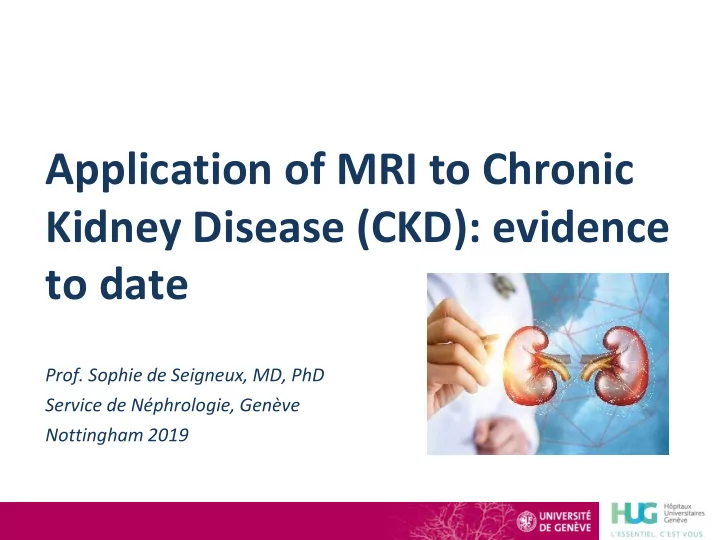

Application of MRI to Chronic Kidney Disease (CKD): evidence to date Prof. Sophie de Seigneux, MD, PhD Service de Néphrologie, Genève Nottingham 2019
Current evidence for MRI in CKD • Recognize a sick kidney • Evaluate non invasively the histology Ct in lung/fibroscan in liver, MRI in heart • Follow non invasively the evolution of a disease • Predict prognosis
Diffusion MRI in healthy and sick kidneys Eisenberg, 2006; Thoeny, Radiology 2005 and 2006
Multiparametric MRI in CKD 22 patients G3/4, 22 healthy volunteers Buchanan, NDT, 2019
Current evidence for MRI in CKD • Recognize a sick kidney • Evaluate non invasively the histology Ct in lung/fibroscan in liver, MRI in heart • Follow non invasively the evolution of a disease • Predict prognosis
Why should we evaluate fibrosis in the kidney? • IF associates to eGFR • If predicts the evolution of renal disease • Treatment choice in selected cases Srivastava, JASN, 2018
Histological evaluation of IF • Standard stainings: trichrome Masson, sirius red, silver • Visually most of the time • Automatization in developpment • Focal and bleeding risk
Diffusion MRI and fibrosis 142 Patients with diabetic nephropathy (43), AKI (23), CKD non diabetic (76) Inoue, JASN, 2011
Correcting for the medulla: ∆ ADC ∆ADC = (ADC cortex) – (ADC medulla) Friedli I et al. Sci Rep. 2016 Jul Fridli et al., JMRI, 2017
∆ ADC external validation r= -0.52 p< 0.001 164 patients 72% allograft 28% native, better results Berchtold et al., NDT 2019
Combining ∆ T1 and ∆ ADC Berchtold et al., NDT 2019
Bold, diffusion and aterial spin labelling 103 kidney allograft recipients Wang CJASN 2019
Arterial spin labeling and capillary rarefaction Wang CJASN 2019
Multiparametric MRI in CKD 22 patients G3/4, 22 healthy volunteers Different fibrosis cutoff Buchanan, NDT, 2019
Diffusion tensor MRI • Diffusion in selected directions( 10-20 directions) • Measures fractional anisotropy (FA), Hartung, JMRI, 2016
MRI elastography 16 allograft recipients with biopsy Kirpalani, CJASN, 2017
Current evidence for MRI in CKD • Recognize a sick kidney • Evaluate non invasively the histology Ct in lung/fibroscan in liver, MRI in heart • Follow non invasively the evolution of a disease • Predict prognosis
Can MRI be used to follow a patient? Nine allograft patients, first imaging at 7 +/- 3 months, second at 32+/-2 months Vermathen, JMRI 2012
Can MRI be used to follow a patient? First biopsy : 12.4 months (IQR: 12.0-49.1) 19 - Protocol biopsy(53%) - Indication biopsy(47%). Second biopsy : 38.4 months (IQR: 23.7-75.5) - Protocol (11%) - Indication (89%) + + Autres 9% Augmentation créatinine 2 yers in fici fici 27% median + + Contrôle après Albuminurie fici traitemen 5% DSA t de rejet 18% 41% L. Berchtold et al, accepted in NDT
Diffusion MRI detects fibrosis aggravation before creatinine elevation L. Berchtold et al, accepted
Current evidence for MRI in CKD • Recognize a sick kidney • Evaluate non invasively the histology Ct in lung/fibroscan in liver, MRI in heart • Follow non invasively the evolution of a disease • Predict prognosis
Can MRI predict CKD evolution? Worst renal outcome : RRT, +30% creatinine Image analyzed 12 layers, Slope and abolute R2* of cortex associated to worse outcome BOLD MRI in 112CKD patients, 47 with HBP, 24 controls patients followed 3 years in median Pruijm et al., KI, 2018
Can MRI predict eGFR slope? 92 patients, native kidneys, 42% diabetes, mean eGFR 49 ml/min/1.73 m2, followed mean 5.13 years. Correlation to eGFR slope Sugiyama, NDT, 2018
Summary • Large improvement in MRI methodology for the evaluation of CKD patients: • Better assessment of renal fibrosis, perfusion and oxygenation • Follow up of patients • Prognosis assessment
The challenges remaining are among others • Use multiparametric MRI and combine complementary sequences • Homogenize the technologies used • Homogenize and automatize the quantification • Apply it in everyday practice? vasculitis w/o biopsy ( anca, pla2r?) before liver/heart transplantation diabetic patients ….
Thank you for your attention Nephrology Radiology Lena Berchtold Jean-Paul Vallée Chantal Martinez Iris Friedli Pierre-Yves Martin Lindsey Crowe Pathology Solange Moll Collaborators Hariett Thoeny Menno Pruijm European the Cooperation in Science and Technology (COST) Action PARENCHIMA (www.renalmri.org)
Recommend
More recommend